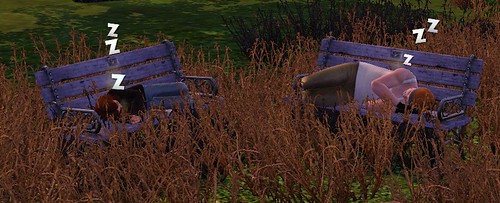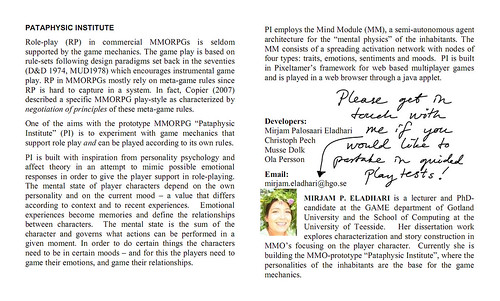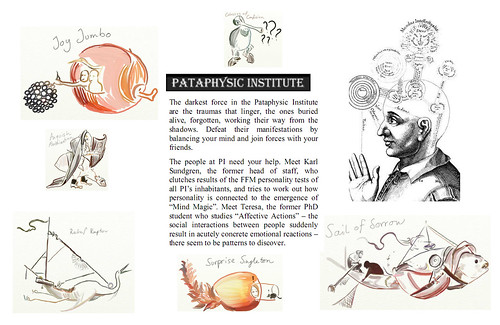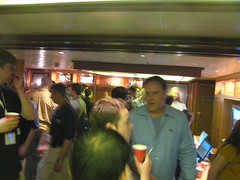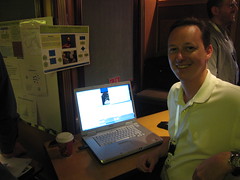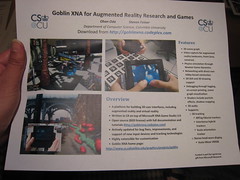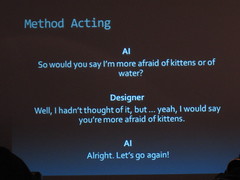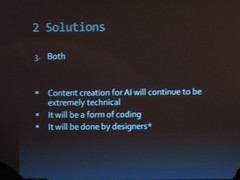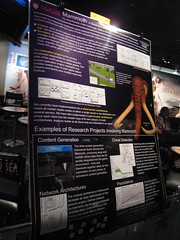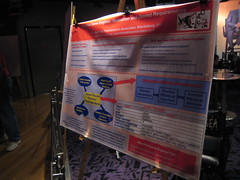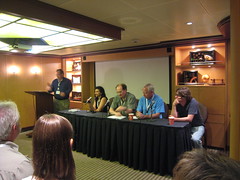The most prominent memories I have from the conference is:
- Richard Bartle's grumpy keynote, where he highlighted the lack of fundamentals of games expressed in formal syntaxes.
- Michael Mateas' speech the day after where he presented an embryo of what Bartle had asked for - an operational logics for games. In the EIS lab he and others, such as Mark Nelson, make applications which generate small games where each game has specific generated rules. Without a way of expressing these rules in abstract combinable ways the work would of course be impossible.
- Noah Wardrip Fruins talk about the concept of agency in games. This was of special interest to me since I have found the term a bit difficult to use in writing. Noah provided a good take on it, i highly recommend reading his paper.
- Doris Rusch's speech about the human condition in games. She brings up an important subject which I have longed for someone to take up in the manner she does.
A strong memory is of how Celia Pearce arranged a dinner for us who had misinterpreted the registration form and had missed out registering for the conference dinner. The whole lot of us went to a pub nearby and had a terrific evening together. Another joyful memory is that of Grethe Mitchell who guided us in London and made sure that Maggie Greene got the food she longed for and the rest of us enjoyed.
I was in a somewhat distracted, or busy, state of mind the first days of the conference. Me and my husband travelled on the Sunday, and on the Saturday I had finalised my PhD thesis after a summer death-march which I hope to never experience again (though the sense of synthesis one gets by relentlessly working around the clock, saying no to everything else, and i mean everything, and overcoming the urge to give up and lay down and die over and over again is quite interesting and wonderful). That left me with having to prepare my two speeches during the conference, and since I was apprehensive about holding them I couldn't really take in information until I had delivered what I was supposed to deliver. But I have the printout of the conference program which I had in my handbag, and from that, and my photos, I can reconstruct a chronology of which presentations I went to.
Day 1
Jenny, Anton, Mattias and me had company on the train on our way to Brunel in the morning. We stayed at a hotel at Baker Street.


Conference Introduction
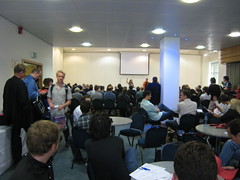
David Roberts held an interesting speech about Game AI as storytelling, but were concentrating on classic zero-sum games such as chess. They were checking trajectories (chains of events) to see which ones would be nice from a narrative perspective. It was great seeing David again. We were in the same lab at GaTech in 2005, and I hadn't seen him since. (... I remember we worried about the customs since I was bringing a decoration gun home to Sweden as a present for my dad, but that it in the end was absolutely no problem, it was endearingly riding in my pink HK bag and the gun got compliments by the customs staff who thought it would be a great present, which it was, my dad loved it... er... I digress.)
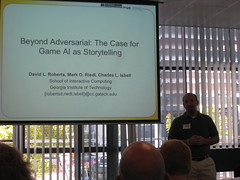
Next was Arnav Jhala and Anders Drachen (formerly Tychsen) whose speech was named "Towards Data Driven Drama Management: Issues in Data Collection and Annotation". They discussed how RPGs are difficult to record given the multiple participants, multitude of story line, and other factors, and described a test made in order to find ways to annotate the material in useful ways, and proposed a DM system. This will be useful for me to look at when planning the next batch of tests to make with PI.
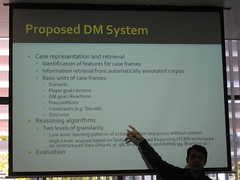
Here is Michael Nitsche
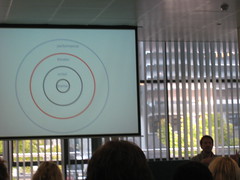
...and Michael Jakobsson:
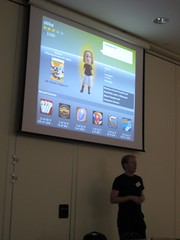
Day 2
I spent the morning in this sofa preparing my speech:

Paul Martin: ‘Meaningful Movement: The Labyrinth and ‘Castlevania: Symphony of the Night’. Paul borrowed my computer (which i had borrowed from my husband) and I was fretting about my own speech, but luckily Paul's speech was so intersting so i forgot about that. His take on spacial puzzles in adventure games was very interesting.
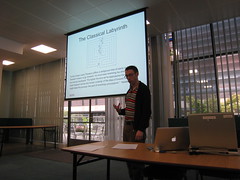
...and then I held my speech. It was titled "Emotional Attachments for Story Construction in Virtual Game Worlds". I gave a recount about how sentiment work in the WoM and PI prototypes, and a play test of them, and what I found. I got a lot of good questions, both about test methods and about issues related to story construction.
The evening before Anders Drachen helped me to size down the presentation (uploaded here), I think we managed to take out more than 20 slides. I which Anders would always be around - I tend to put too much into the presenations, afraid that I will forget something important.
Doris Rusch: Mechanisms of the Soul – Tackling the Human Condition in Videogames:
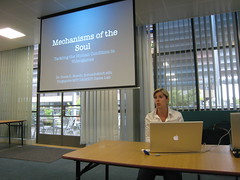
digra meeting, new board was appointed
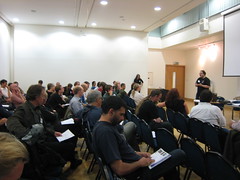
Day 3
Just before lunch I participated in a panel moderated by Markinka Copier, whith Jaakko Stenros, Anders Drachen, Michael Hitchens, and Marcus Montola. We discussed the subject "Role-Playing Games: The state of knowledge." We had each prepared a short presentation (mine is uploaded here), and then the discussion was steered by Marinka and questions from the audience. I remember it as an interesting discussion where many different viewpoints and opinions were voiced in good humour. Afterwards someone asked what the conflict had been about that was reported on Twitter, but I don't remember any real conflict, or even heat, but then again I don't trust my own judgement on those kinds of issues. In our panel we each talked about RP in quite different settings - Jaakko concentrating on the Nordic LARP scene, Marcus digging up very controversial RP topics on many different platforms and Michael and Anders more focused on table top RPing and game mastering while I am more focused on systemic aspects of RP possibilities (and how to engineer systems for them) in MMOs.
The afternoon was filled with keynotes.
Mark Haley and his colleague told us about how the team behind Little Big Planet worked with the art for the game.
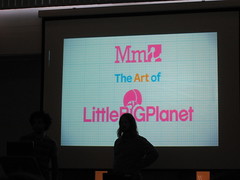
Richard Bartle started out his keynote with listing things he did not want to see in research focusing on games. He was pointing at examples of bad research practice, and I think many of us in the audience were doing backtracks: "am I guilty of this?"
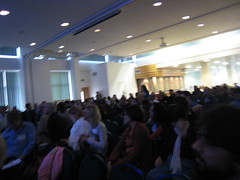
The point he was getting to in the end was this:
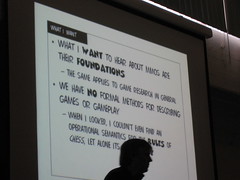
The day after he elaborated on the need for formalism in game studies in a blogpost at the following URL:
http://www.youhaventlived.com/qblog/2009/QBlog040909B.html
In his keynote 'Video Games are a mess' Ian Bogost ran through a number of potential answers to the question 'What is a game?', and gave recount of the old ludology-narratology debate. He then went on to the subject of platform studies and raised some philosophical questions (speculative realism).
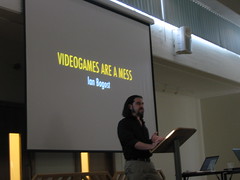
In the evening those of us who had misunderstood the registration form detail about the conference dinner gathered at a pub, herded there by Celia





Day 4
David Myers: In search of a minimalist game

Mike Treanor: Newsgames:Procedural Rhetoric meets political cartoons

Douglas Easterly: Evolutionary Connections for Digital Gaming

Justin Parsler: Agency and Free Will Debate
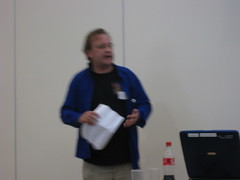
Noah Wardrip Fruin: Agency Reconsidered
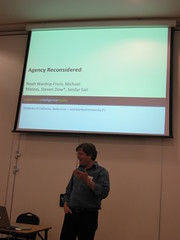
Michael Mateas: Defining Operational Logics
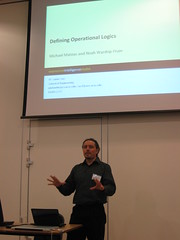
dinner day 4










